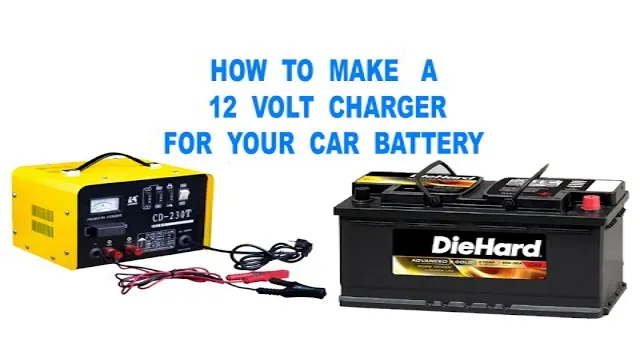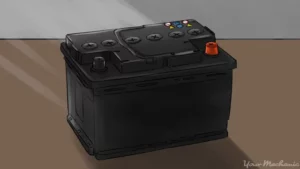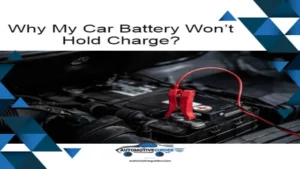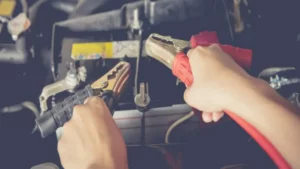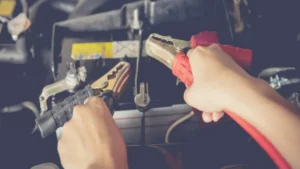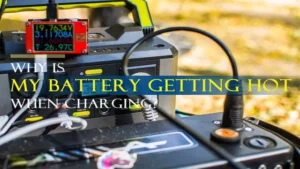If you’re looking for a way to recharge your car battery without having to rely on a professional, a 12-volt car battery charger could be just what you need. And the best part? You can make one yourself! It doesn’t require any technical knowledge or expensive equipment, just a bit of know-how and some spare time. In this article, we’ll show you how to make a 12-volt car battery charger from scratch, so you can save money and enjoy the satisfaction of doing it yourself.
So, grab your tools and let’s get started!
Materials Needed
If you’re looking to make your own 12 volt car battery charger, there are a few materials you’ll need to get started. First, you’ll need an AC to DC power adapter that can handle at least 5 amps of current.
You’ll also need a diode, which will prevent the battery from discharging when the charger is unplugged. Additionally, you’ll need a transformer to reduce the voltage from the power adapter to the appropriate level for charging your battery. Finally, you’ll need some basic tools like wire cutters and strippers, pliers, and a soldering iron to assemble everything.
Keep in mind that working with electronics can be dangerous, so be sure to follow all safety guidelines and proceed with caution. With the right materials and a bit of know-how, you can create a functional car battery charger that will keep your vehicle running smoothly.
Car battery
When it comes to car batteries, there are a few essential materials that you’ll need for routine maintenance and upkeep. Firstly, a pair of safety goggles and heavy-duty gloves should always be worn while working with car batteries to protect yourself from any acid or chemicals. You’ll also need a battery post cleaner to remove any buildup on the posts and connectors of the battery that may reduce the performance of the battery.
A voltmeter or multimeter is another necessary tool to measure the voltage of the battery to determine if it’s holding a charge or requires a recharge. Additionally, having a battery charger or jump starter on hand can save you from being stranded in case of a dead battery. If you don’t have access to an electrical outlet, a portable battery jumper pack is an excellent alternative.
Remembering to check and maintain your car battery regularly can prevent its failure and extend its lifespan.
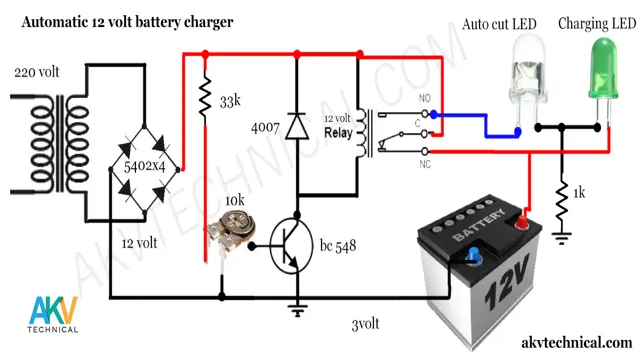
12V AC adapter
If you’re in need of a 12V AC adapter, you’ll need a few materials to get started. First and foremost, you’ll need the adapter itself. Make sure to find one that is compatible with your device and that has the appropriate voltage and amperage ratings.
You’ll also need a power cord to connect the adapter to an outlet. Make sure the cord is long enough to reach your desired location and that it is in good condition with no frayed wires or damage. Finally, if you plan on using the adapter frequently, you may want to invest in a surge protector to protect both the adapter and your device from power surges.
With these materials, you’ll be able to power your device with ease using a reliable 12V AC adapter.
Multimeter
If you’re looking to measure current, voltage or resistance, a multimeter is an essential tool for any DIY enthusiast or professional electrician. To get started, you’ll need to gather a few materials to ensure you can properly test and diagnose electrical problems. The most important item, of course, is the multimeter itself, which can be found at most hardware stores or online retailers.
In addition, you may also need some electrical tape, safety glasses, and a pair of insulated electrical gloves to ensure you’re working safely and protecting yourself from electrical hazards. Once you have these materials, you can confidently tackle any electrical project with the precision and accuracy that a multimeter provides. So go ahead and grab your multimeter and get ready to tackle your next electrical challenge!
Diode
If you’re interested in building your own electronic circuits, then you will need some basic materials. For building a diode, you will need a piece of silicon or germanium, which are both semiconducting materials. These materials are often sold in small pellets or crystal ingots and have to be carefully prepared.
Additionally, you’ll need to coat the semiconductor material with a layer of impurities on either side to create the PN junction. Usually, this is done by adding boron to one side and phosphorus to the other. This process is called doping and results in a material that conducts electricity in one direction but blocks it in the other direction, making it a diode.
You will also need a battery, a resistor, and a voltmeter to test your diode. When constructing electronic circuits, it’s important to use high-quality components and follow best practices so that your project is safe and performs well.
Fuse
If you’re planning to work with electrical systems or appliances, having the right fuse is crucial for safety reasons. The materials required to replace or install fuses vary depending on the type of fuse it is. Some fuses use cartridge-type fuses which require specific replacement cartridges.
Others have blade-style fuses, which are more commonly found in automobiles and need compatible replacement blades. Not having the right type of fuse can result in electrical surges or even a fire, causing severe damage to your equipment or property. Therefore, it’s best to consult the fuse’s manufacturer or obtain professional guidance if you are unsure of which fuses to use.
Investing in good quality and compatible fuses will go a long way in keeping your electrical systems and appliances safe.
Wires
When it comes to working with wires, there are a few essential materials that you don’t want to be caught without. First and foremost, you’ll need the wires themselves! These come in many different gauges and lengths, so be sure to choose the right size for the project you’re working on. Next up, you’ll need wire strippers.
These handy tools allow you to remove the insulation from the wire, so you can make connections and create circuits. You’ll also need wire cutters, pliers, and a soldering iron or crimping tool, depending on how you plan to connect your wires. Finally, it’s a good idea to keep some electrical tape on hand, as well as wire nuts and heat shrink tubing, in case you need to splice wires together or insulate your connections.
With these materials on hand, you’ll be able to tackle all sorts of projects involving wires!
Steps to Build the Charger
If you’re wondering how to make a 12-volt car battery charger, you’re in the right place. There are a few simple steps you can follow to build one yourself. First, you’ll need to gather the necessary components, including a transformer, diodes, capacitors, and a metal case.
Then, you’ll need to assemble the circuit, making sure to follow the schematic diagram carefully. Once the circuit is assembled, you can connect it to the metal case and add a fan to help dissipate heat. Finally, you’ll want to test the charger to ensure it’s working correctly and make any necessary adjustments.
With a little time and effort, you can have a reliable and cost-effective 12-volt car battery charger ready to use.
Step 1: Connect the Diode
Building a charger for your device is not as difficult as it may seem. The first step in building your very own charger is to connect the diode. The diode is an essential component in a charger as it helps to prevent your device from overcharging and causing any damage.
When connecting the diode, it is important to ensure that you attach it to the right terminals. The diode should be connected between the positive wire and the positive terminal of the charger, with the striped end facing towards the charger. Once the diode is correctly connected, you can move on to the next step.
By following these simple steps, you can create a charger that is efficient, safe, and reliable.
Step 2: Connect the Fuse
When building a charger, connecting the fuse is one of the essential steps. The fuse acts as a safety mechanism that protects your device from potential electrical hazards such as a short-circuited wire. It is crucial to choose the right fuse for your charger, depending on the device’s voltage and amperage.
Once you have selected an appropriate fuse, it’s time to connect it to the circuit. You can use a fuse holder or solder it directly onto the circuit board. Before connecting the fuse, ensure that the circuit is grounded, and there are no loose wires or connections.
Connect the fuse with the positive wire, which is typically red, and ensure that it is secure. Remember, a faulty fuse can damage your device, so pay attention to this step and take extra caution.
Step 3: Connect the Wires and Multimeter
When it comes to building a charger, connecting the wires and multimeter is a crucial step. It’s important to follow instructions carefully, so you don’t damage any components and create an unsafe charger. First, attach the wires to the battery terminals, ensuring you connect positive and negative correctly.
Then, connect the wires to the other components in the circuit, following the schematic provided. Once all the wires are in place, you’re ready to use the multimeter to test the voltage levels at various points in the circuit. This will help you identify any issues and ensure everything is working correctly.
Don’t forget to use safety precautions like gloves and eyewear when handling the wires and other components. With careful attention to detail, you can build a safe, effective charger that will keep your devices powered up when you need them.
Step 4: Connect the Charger to the Battery
After assembling the AC plug and the rectifier bridge, it’s time to connect your charger to the battery. First, locate the positive and negative terminals on your battery and attach them to the corresponding terminals on the charger. It’s important to ensure that the polarity is correct, or else you can damage your battery or charger.
Double-check your connections before turning on the power, and if everything looks good, switch on the power to begin charging. Keep an eye on the charging progress and disconnect the charger once your battery has reached its recommended voltage. Don’t forget to unplug your charger from the AC outlet before disconnecting it from the battery.
By following these steps, you can successfully build and operate your own battery charger. Whether you’re using it for vehicles, off-grid power systems, or other applications, a DIY charger can save you money and give you the satisfaction of building something yourself.
Safety Precautions to Follow
If you’re planning on making a 12 volt car battery charger, safety should be the top priority. Before getting started, make sure you have proper safety gear such as gloves and safety glasses. It’s also important to work in a well-ventilated area to avoid inhaling toxic fumes.
When wiring the charger, ensure that all connections are tight and secure to prevent any electrical shorts. Furthermore, it’s vital to use a charger that is specifically designed for car batteries to avoid overcharging or damaging the battery. If you’re unsure of what you’re doing, it’s best to seek advice from a professional before attempting to make a charger on your own.
By following these safety precautions, you can ensure that your 12 volt car battery charger is made safely and effectively.
Wear safety goggles
When it comes to engaging in activities that pose a danger to your eyes, it’s important to take the necessary safety precautions to prevent any possible harm. One crucial measure is to always wear safety goggles. Whether you’re working in construction, woodworking, or any other profession that involves tools and machinery, wearing goggles will protect your eyes from flying debris, harmful chemicals, and other hazards.
It’s easy to take this simple step for granted, but without them, there’s a higher risk of vision impairment or even permanent blindness. Don’t forget – an ounce of prevention is worth a pound of cure! Make a habit of wearing safety goggles every time you engage in activities that could jeopardize your eyesight.
Work in a well-ventilated area
Ensuring safety should always be a top priority, especially when working with potentially hazardous materials or tools. One important safety precaution to follow is to work in a well-ventilated area. This means providing adequate airflow by opening windows or using a ventilation fan to reduce the risk of inhaling harmful fumes or particles.
Even if you’re working with materials that aren’t known to be harmful, it’s always a good idea to ensure good air quality to prevent respiratory discomfort and fatigue. Remember to wear protective gear to further minimize potential harm, such as a face mask or respirator, gloves, and safety glasses. By taking these simple steps, you can protect yourself from potential harm and ensure a safe and productive working environment.
So, make sure to prioritize safety and work in a well-ventilated area every time.
Use proper tools and equipment
When it comes to working with tools and equipment, safety should always be a top priority. Using proper tools and equipment can make tasks not only safer, but also more efficient and effective. It’s essential to use tools and equipment that are appropriate for the job at hand and to follow all safety instructions carefully.
This can mean using protective gear like goggles, gloves, or earplugs, and making sure that tools are in good working condition before using them. It’s also important to keep workspaces clean and organized to minimize the risk of accidents. Remember, taking the time to follow safety precautions can mean the difference between a successful project and a dangerous mishap.
So, take the necessary precautions to stay safe while using tools and equipment for any task.
Conclusion
Well, there you have it, folks! With the steps outlined above, you can easily make your own 12 volt car battery charger. Not only will you save money by making it yourself, but you’ll also gain a sense of satisfaction from creating something useful and practical. Plus, you’ll never be caught with a dead battery again! So, get your hands dirty and start crafting your very own charging solution, and you’ll be the envy of all your friends.
Remember, with a little bit of knowledge and some basic tools, anything is possible!”
FAQs
What materials are needed to make a 12-volt car battery charger?
To make a 12-volt car battery charger, you will need a transformer, diode, capacitor, resistor, and a few other components.
Can I use a 12-volt battery charger for a car battery?
Yes, a 12-volt battery charger can be used for a car battery. However, it is important to choose the right charger for your specific car battery.
How long does it take to charge a car battery with a 12-volt charger?
The charging time for a car battery with a 12-volt charger depends on the size and condition of the battery. It can take anywhere from a few hours to overnight.
Is it safe to leave a car battery charging overnight with a 12-volt charger?
It is generally safe to leave a car battery charging overnight with a 12-volt charger, as long as the charger is in good condition and the battery is not overcharged.
Can I charge a dead car battery with a 12-volt charger?
Yes, a 12-volt car battery charger can be used to charge a dead car battery. However, it is important to ensure that the battery is not completely dead or damaged.
How much voltage is needed to charge a 12-volt car battery?
A voltage of around 13 to 14 volts is needed to charge a 12-volt car battery. However, it is important to use the right charger and follow the manufacturer’s instructions.
Can I use a solar panel as a 12-volt car battery charger?
Yes, a solar panel can be used as a 12-volt car battery charger. However, it is important to choose the right size and type of solar panel for your specific car battery.
